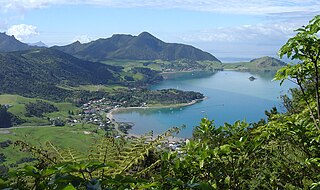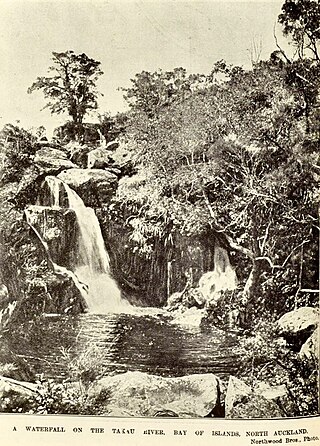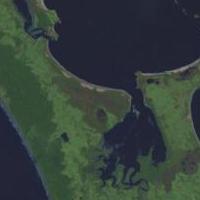Related Research Articles

The Northland Region is the northernmost of New Zealand's 16 local government regions. New Zealanders sometimes refer to it as the Winterless North because of its mild climate all throughout the year. The main population centre is the city of Whangārei, and the largest town is Kerikeri. At the 2018 New Zealand census, Northland recorded a population growth spurt of 18.1% since the previous 2013 census, placing it as the fastest growing region in New Zealand, ahead of other strong growth regions such as the Bay of Plenty Region and Waikato.

Waipoua Forest is a forest, on the west coast of the Northland Region of New Zealand's North Island. It preserves some of the best examples of kauri forest remaining in New Zealand. It is notable for having two of the largest living kauri trees, Tāne Mahuta and Te Matua Ngahere.

Dargaville is a town located in the North Island of New Zealand. It is situated on the bank of the Northern Wairoa River in the Kaipara District of the Northland region. Dargaville is located 55 kilometres (34 mi) southwest of Whangārei, and 174 kilometres (108 mi) north of Auckland.

The Far North District is the northernmost territorial authority district of New Zealand, consisting of the northern part of the Northland Peninsula in the North Island. It stretches from North Cape / Otou and Cape Reinga / Te Rerenga Wairua in the north, down to the Bay of Islands, the Hokianga and the town of Kaikohe.
Lake Ōmāpere is the largest lake in the Northland Region of New Zealand. It is located to the North of Kaikohe.

Although not as prominent as its eastern namesake, Northland's Mount Hikurangi is also of note. At 625 m (2,051 ft), this peak overlooks central Northland and is a prominent peak on the skyline at the Bay of Islands, the area of the first permanent European settlement in New Zealand.
Umawera is a community in Northland, New Zealand. State Highway 1 runs through the community. Mangamuka Bridge is to the northwest, and Rangiahua is to the east. Umawera is part of the Omahuta Forest-Horeke statistical area, which covers the upper Hokianga Harbour. For demographics of this area, see Horeke.

Whangarei District is a territorial authority district in the Northland Region of New Zealand that is governed by the Whangarei District Council. The district is made up in area largely by rural land, and includes a fifth of the Northland Region. It extends southwards to the southern end of Bream Bay, northwards to Whangaruru and almost to the Bay of Islands, and westwards up the Mangakahia River valley past Pakotai and almost to Waipoua Forest. It includes the Hen and Chicken Islands and the Poor Knights Islands.
The Punakitere River is a river of the Northland Region of New Zealand's North Island. It is a tributary of the Taheke River, which forms the Waimā River, though it is longer than the Waimā itself. The Punakitere is polluted, especially with e-coli and phosphorus, and has its origins in several streams which flow through and to the south of Kaikohe, as well as from Mount Hikurangi. The rivers flow predominantly westward to reach the Waimā close to the small settlement of Moehau.

The Tākou River is a river of the Northland Region of New Zealand's North Island. It flows generally east from its sources east of Kaeo to reach the Pacific Ocean at Tākou Bay, 14 km (8.7 mi) north of Kerikeri.
The Utakura River is a river of the Northland Region of New Zealand's North Island. It flows west from its sources northwest of Kaikohe, reaching the Waihou River at the point where it widens to become an arm of the Hokianga Harbour.
Lake Morehurehu is a dune lake in the Northland Region of New Zealand. It is located to the Northeast of Te Kao on the Aupouri Peninsula.

Lake Ngatu is a dune lake in the Northland Region of New Zealand. It is located to the northwest of Awanui, near Waipapakauri.
Lake Rotoroa is a dune lake in the Northland Region of New Zealand. It is located to the west of Awanui.
Lake Te Kahika is a dune lake located on the Aupouri Peninsula in the Northland Region of New Zealand. It is one of the country's northernmost lakes.
Lake Waiparera is a dune lake in the Northland Region of New Zealand. It is located immediately North-West of Waiharara on the Aupouri Peninsula. The lake is the largest of the Aupouri Lakes. The catchment is predominantly pasture, with the remainder scrub or wetland. The lake has several inflows (drains), with no obvious outflows. The lake is easily accessed from SH1.
Lake Waiporohita is a dune lake in the Northland Region of New Zealand. It is located near Tokerau Beach on the Karikari Peninsula.

The Kaimaumau wetland is a wetland by the Rangaunu Harbour, in Northland, New Zealand. At approximately 1,860 hectares, it is one of the largest remaining wetlands in Northland. It comprises the Otiaita and Waihauhau swamps, Motutangi Swamp Scientific Reserve, and Lake Waikaramu. The wetland is currently threatened by peat mining and by water loss from avocado growing.

The Northland District Health Board is a district health board with the focus on providing healthcare to the Northland Region of New Zealand. In July 2022, the Northland DHB was merged into the national health service Te Whatu Ora.
The Kai Iwi Lakes are located in Taharoa Domain in the Northland region of New Zealand. The reserve encompasses a series of three freshwater dune lakes: Lake Taharoa, Lake Kaiiwi, and Lake Waikare, sometimes called Lake Waikere.
References
- ↑ "Lake Carrot". Lakes380. Retrieved 17 August 2024.
- ↑ "Environmental data hub". Northland Regional Council. Retrieved 17 August 2024.